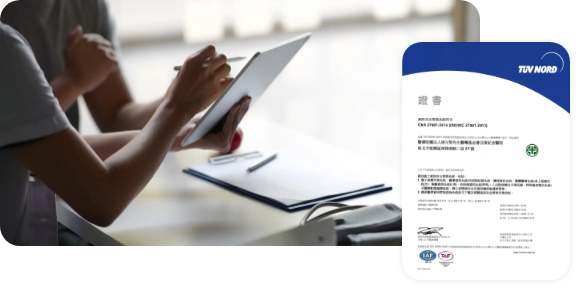

Risk and Crisis Management
To protect the safety of patients and employees, FEMH established the “Risk and Crisis Management Committee” and adopts the risk analysis tool “Hazard Vulnerability Analysis” to conduct various key hazard and risk assessment on disaster, climate change, and the geographic environment near the hospital, according to ISO 31000 and 2018 Risk Management Framework each year. The analysis of FEMH 2019-2021 crisis incident and the evaluation of the external environment and other factors have classified (1) Climate Change, (2) Information Security and (3) High-Risk Infection as the key disclosure items of the report.
Climate Change
Information Security
High-Risk Infection
Hospital Risk Management and Emergency Disaster Response
The framework of FEMH’s “Hospital Risk Management and Emergency Disaster Response” is complete with remarkable operating effect. In 2020, New Taipei City Department of Health recommended FEMH participate in the National Healthcare Regional Counseling and Medical Resource Integration Program Hospital Competition, winning recognition and presentation in Benchmark Hospital Award. In 2021, FEMH participated in the 2021 “National Critical Infrastructure Protection and Visit Exercise” held by the Executive Yuan and was cognized with appreciation.
- Picture 1: Participated in National Healthcare Regional Counseling and Medical Resource Integration Program, recognized and presented with Benchmark Hospital Award.
- Picture 2: Letter of Appreciation for “National Critical Infrastructure Protection and Visit Exercise.”
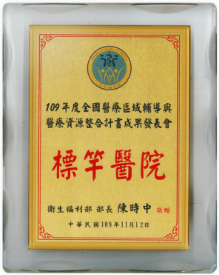
Picture 1
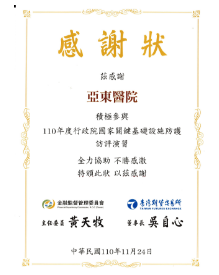
Picture 2
Climate Change
Global climate change threatens the health of humans while hospitals serve as the sites operating 24 hours a day and are one of the high power-consumption industries. Hospitals also bear the burden to protect public health and need to implement energy saving and carbon reduction in daily operations. FEMH established the Energy Saving and Carbon Reduction Project Team to propose improvement actions for all power consumption systems, in attempt to fulfill corporate social responsibility, save energy and reduce carbon emission for the earth.

Energy and Resource Control Procedures
The team develops the “Energy and Resource Control Procedures” to manage six dimensions, including air conditioning, lighting, water consumption, gasoline consumption, steam, and electronic appliances, with the proposal of intermediate to long-term goals.
Air Conditioning
Lighting
Water Consumption
Gasoline Consumption
Steam
Electronic Appliances
01
Short-Term Goals:
- Boost energy recycling and reuse rate (condensed water recycling, rainwater recycling, steam recycling).
- Save electricity by 1% or more per year.
- Green procurement over NT$5 million or more per year.
- Recycling rate for waste medical plastics from the biomedical wastes in Hemodialysis Unit reaching 80%.
02
Intermediate to Long-Term Goals:
- Establishing energy management system and boosting energy consumption efficiency.
- Phasing out air conditioning system from old campus eventually, in order to maintain the power consumption indicator of side water system lower than 0.75 kw/RT.
Energy and Greenhouse Gas Management
The main energy of consumption for FEMH is electricity outsourced, natural gas and diesel. In 2021, the total power consumed by FEMH was 49,153,600kWh, natural gas consumed was 912,098m3 and diesel consumed was 10,000L. Moreover, electricity accounts for more than 93% of hospital-wide energy consumption. The expansion of Phase II campus construction drove to the increase in energy consumption, and FEMH installed a frequency-variant air conditioning system, heat pump systems, ice storage, and second steam recycling system as well as the power modulating measures for peak/off-peak air conditioning, leading to the drop in energy usage index after expansion (hereinafter referred to as EUI), which lowered from the 346.52kWh/m2/year before expansion to the 253.26 kWh/m2 /year after expansion. The carbon emission also lowered from 39,000 tons /year to 30,000 tons/year. FEMH is scheduled to introduce ISO 50001 by March 2022 and shall validate in November to assure the actual implementation of the lasting mechanism of energy management.
Energy Consumed in 2021
The Power Consumed Was
The Natural Gas Consumed Was
The Diesel Consumed Was
Energy Consumed Before and After Expansion
Before Expansion
Energy Usage Index(EUI)
346.52
kWh/m2/Year
Carbon Emission
3.9
Tons/Year

After Expansion
253.26
kWh/m2/Year
3
Tons/Year
Power-Saving Measures
The clinic lobby is installed with LOW-E glass to effectively insulate thermal conductivity and effusion of air conditioning. During the day, the glass can fully introduce light to reduce the use of lighting fixtures in day time. The region without personnel is installed with Infrared sensing lights while the outdoor lamp posts are scheduled through computer control, which is incorporated with LEF lighting to save approximately 323,033 kWh in power consumption each year. The “water-based heat pump” applies the energy conversion and power-saving effect of the heat pump by transferring the chilling system and thermal energy of the computing room to the ice barrel for storage and use by the hospital. A total of 10 heat pumps are available in the hospital, which reduce carbon emission by approximately 7,850,290kg per year. Between 2019 and 2021, FEMH was devoted in various power-saving plans by phasing out old equipment, improving lighting/air conditioners and other items, saving approximately total power consumption by 3,198,033 kWh.
Power Consumption Save Approximately
Heat Pumps Reduce Carbon Emission Approximately
Phasing Out or Improving Old Equipment and Other Items, Saving Approximately
Air Quality and Pollution Improvement Team
The air quality and pollution improvement team is formed to establish automatic monitoring system and pollution-linked reporting. The automatic monitoring system of air-conditioning is combined with ion equipment to improve the air quality indoor. The autonomous examination and testing results by third impartial unit conform to the standards. In 2021, FEMH was awarded by the EPA with “Environmental Protection Specialist and Technician in Indoor Air Quality Maintenance and Management Model,” receiving a letter of appreciation from the EPA and called by the President for recognition.
- Picture 1: EPA Letter of Appreciation
- Picture 2: Award Presentation Ceremony for “Environmental Specialist and Technician”
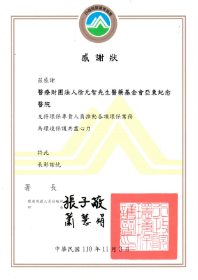
Picture 1
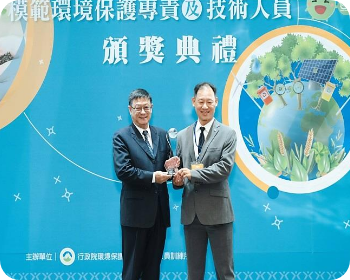
Picture 2
Water Resource Management
The source of water for FEMH is Taipei Feitsui Reservoir, which goes through Bansin Water Treatment Plant-Puqian pressure for water supply. The water quality is relatively clean and stable. The Water Resource Agency of Ministry of Economic Affairs points out that all counties/cities of Taiwan will face with severe water shortage issues by 2030, if the issue of climate change could not be alleviated. FEMH has developed the “Tap Water System and Water Pumping Equipment Management Regulations.” FEMH inspects the total number of tap water consumed weekly while the central control room monitors the water supply and discharge pump operations with the installation of abnormal alert report. Statistics show that the water consumption for 2021 was down 4.03%, compared with previous year. The “recycling and reuse” and “water reduction” strategies are adopted to conduct water resource management, with the establishment of rainwater, RO water, and condensed water recycling system. The waste water amount recycled each year is approximately 17,520m3, which saves about NT$222,760. The waste water recycling and reuse is both environmentally green and energy saving.
Water Consumption for 2021 was Down
Waste Water Amount Recycled Each Year is Approximately
Waste Water Amount Recycled Saves About
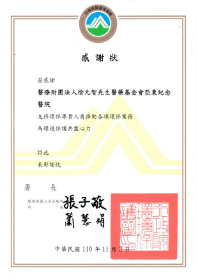
Picture 1
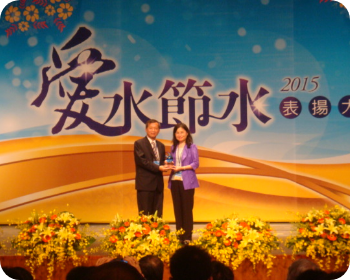
Picture 2
Steam Recycling and Energy Saving for Environmental Protection Program
Additionally, the secondary steam recycling system recycles the steam through treatment and for use by the boiler to reduce the burning burden on the boiler. Each year, approximately 14,490.0 tons of condensed water can be recycled from the boiler steam. The “Steam Recycling and Energy Saving for Environmental Protection Program” was awarded the Health Hospital Creative Plan in the category of Low-Carbon Sustainability Excellence in 2019. The daily management and inspection through continuous promotion of water conservation programs truly implement the effectiveness of water conservation. FEMH was recognized by Taiwan Water Resources Agency at the award ceremony.
- Picture 1: Health Hospital Low-Carbon Sustainability Category – Excellence Award
- Picture 2: Water Conversation Award
Improves Academic Research Capacity
Apart from implementing water conservation measures, FEMH also constantly improves its academic research capacity by submitting papers to American SCI Journal -JNN and published the “Aqueous Oxytetracycline and Norfloxacin sonocatalytic degradation with multilayer Sheet-like ZnO in the presence of peroxydisulfate” in 2021, thereby integaring industry practice and academic resarch in order to bring more synergy into effect.
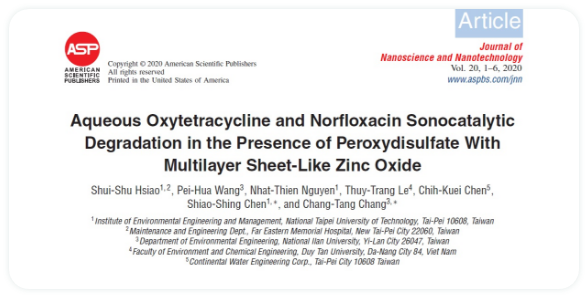
Waste Management
The “Regulations Governing Waste Management” were developed in accordance with “Environmental Protection Act,” along with the formulation of waste classification table for the execution of waste classification, reduction and recycling. Due to the advancement in recycling and sterilization technology, some biomedical wastes could be recycled, treated, and reused, in order to reduce the production of biomedical wastes. FEMH produced a variety of wastes in four categories, including: 1 general wastes, biomedical wastes, recycling and reuse of biomedical wastes from the hemodialysis room, and recycling, were all committed to the government accredited professional waste treatment companies, adopting high-temperature incineration treatment, recycling and reuse. FEMH strives to make contribution to the environment by proactively promoting waste reduction:

Measures of Waste Reduction
- Strengthen peer education and training.
- Control by segment and lower error in classification.
- Recycling and reuse of biomedical wastes.
FEMH advocates for the recycling treatment and reuse of some biomedical wastes, in order to reduce the production of biomedical wastes. The weight of biomedical waste plastics has increased annually, up 9.3% in 2021 compared with previous year. Between 2019-2021, the service capacity of all medical services for FEMH emergency room and hospitalization has grown drastically. After FEMH has addressed the specific measures of waste reduction,the average monthly treatment volume for the recycling of biomedical waste plastics have significantly grown, up by 445KG in 2021, compared with previous year. The average monthly general waste produced in 2021 was down by 5,833 KG in 2021, compared with the previous year, lowering as high as 6.50%.
Production and Treatment Volume of Wastes in 2021
The Recycling of Biomedical Waste Plastics
General Waste
Average Monthly Treatment Volume Compared with Previous Year have Grown
The Weight of Treatment Volume have increased
The Average Monthly Produced in 2021 Compared with Previous Year was Down
The Production Amount Lowering As High As
Information Security
Pursuant to the Cyber Security Management Act and the matters /protection standards stipulated by the Ministry of Health and Welfare, and the ISO 27001 standards, the “Information Security Management Committee” was established as a dedicated organization to promoting information security protection. Additionally, the “Information Management Committee” was established to periodically follow up the matters related to information security. The Security Operation Center (SOC) monitors and handles immediately 24 hours a day with periodical vulnerability scanning, executing the examination of information security.
FEMH has joined the Ministry of Health and Welfare- Information Sharing and Analysis Center (H-ISAC) platform to acquire warnings related to information security instantly for prevention. FEMH conducts one external audit (ISO 27001) and two internal audits with establishment of dedicated system that administers flaws or reminders. FEMH has passed the ISO 27001 certificates consecutively since 2009. The “Personal Information Protection Team” administers the general matters of personal data protection. FEMH also develops the “Persona Data Protection Regulations” with relevant standards and rules stipulated. The medical history is an important personal data of the hospital. The “Medical History and Electronic Medical History Management Committee” promotes the management and protection of medical history. FEMH has demonstrated excellent performance in personal data management and protection, and has not received any complaints for the disclosure of any personal data.
